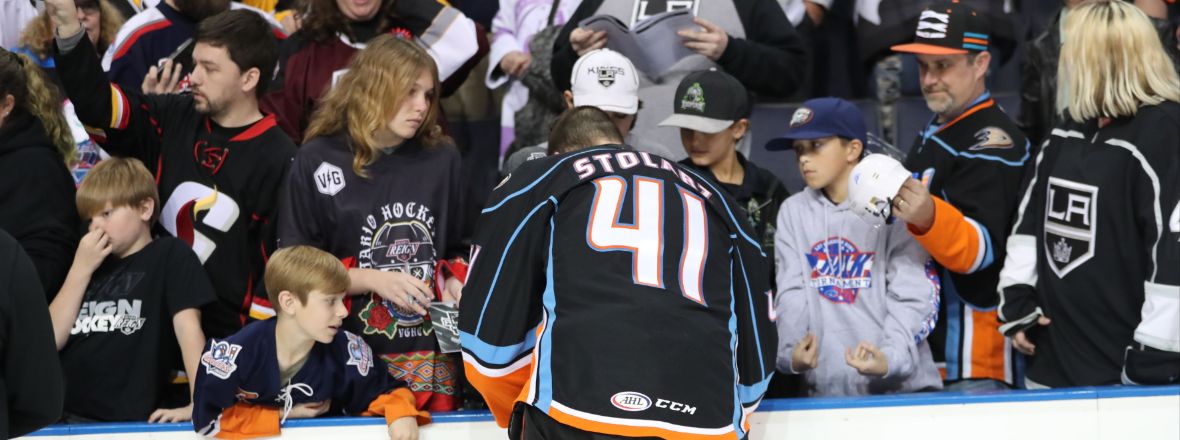
Andrews Talks Pacific Division at State of League Address
Jan 27, 2020By AJ Manderichio/SanDiegoGulls.com
The sun shone over the mountains outside the Ontario Convention Center, highlighting the faint outline of some remaining snow on the tips of the landscape.
It’s a stark change from what Dave Andrews, the American Hockey League (AHL) President and CEO, usually sees at the league’s annual AHL All-Star Classic festivities.
“One bonus to that is to have the All-Star Game somewhere where it’s warm,” he said today during his annual State of the League address. “Yesterday didn’t look quite so California-ish, but getting up and walking over here this morning was pretty special. Very thankful to be here, and I’m sure all of those that came from the East, Winnipeg or any of those places up north; this is pretty nice.”
The Pacific Division celebrates its fifth season in the league this year, and the All-Star festivities in Ontario help highlight the league’s expansion to the West Coast.
Andrews, who will retire at the end of this season, reflected on one of the greatest achievements of his tenure – establishing the AHL’s Pacific Division.
“If I look back over my career, there’s two real watershed moments,” he said. “2001, when we took over the International Hockey League’s remaining six teams and brought them into the AHL. That brought us really strong ownership and really strong markets, and led us to a position where we had all the NHL teams in the league as affiliates, and eliminated our competition at the time. In any business, when you can eliminate your competition, it puts you in a much better spot.
“Between then and 2015, the next big moment was Pacific Division expansion. That took us two or three years to accomplish; it was a difficult process, but certainly one that’s really added to our footprint and added to the strength of our markets and ownership. Most importantly, this has made seven NHL teams at this point – and soon to be eight – very happy with the American Hockey League and their location and their player development model.”
The clubs aren’t just part of the league – they’re setting the tone. Andrews specifically pointed out the work done by San Diego and Ontario as proof of the division’s successful entrance into AHL hockey.
“The idea of a West Coast presence has grown to where the geography out here will actually have as many teams as any geography we have,” he explained. “It’s certainly been very successful. Two of them are in the top five of the league in their business in Ontario and San Diego; great additions to the league. Bakersfield is doing great and continues to grow their business. San Jose is looking for a new building for their American League team, which we welcome for them and for us, so they can have their own location.”
No one would blame Andrews for basking in the success of his Pacific Division. The league’s President and CEO, however, said all the credit goes to the individual organizations.
“This was an initiative driven by the West Coast teams, and if you look at the success of these teams, the amount of energy and investment they’ve made, it’s a credit to them,” he said. “The initial move – the negotiation of it – was heavy lifting. But the success afterward, that wasn’t us. It’s you guys in San Diego, the staff here in Ontario, it’s the commitment financially the teams have made to make this work. It’s an investment by those clubs and the type of leadership they put in place, like Matt [Savant, President of Business Operations] in San Diego and Darren Abbot [President, Ontario Reign] and Steve [Fraser, Vice President of Business Operations, Ontario Reign] here. If you’re going to be successful, that’s what it’s all about – team’s investing in good leaders and staffs. I don’t think we could claim a lot of credit for it.”
The league entered California as interest in hockey reached a fever pitch. USA Hockey’s latest statistics – reported on the site in 2016-17 - show a 25.2% jump in participation of eight-and-under players in its history. Participation among girls jumped 49%, a new record high.
USA Hockey’s 2018-19 statistics report over 62,000 currently playing in the Pacific area.
It’s important for Andrews – and the league’s future – to continue its investment in helping grow the game.
“We work very closely with USA Hockey, we work very closely with Hockey Canada and the growth of the game is important to us,” he said. “The involvement of our teams in the growth of the game in the community is important to us. If you look at the fact we have over 27 markets in the U.S. that are not NHL markets, we’ve made an impact. Our players do a lot at the community level to get out and work with kids. I think we’re very proud of that. We’re working hand in hand with the NHL, and we’re very proud of that, in terms of our involvement now in a number of the NHL’s grow the game programs.”


